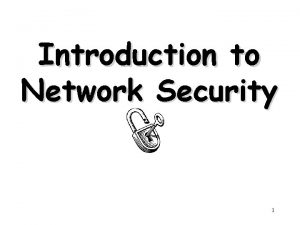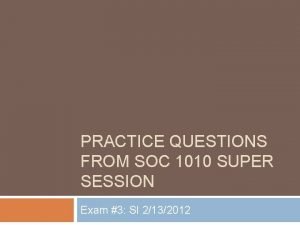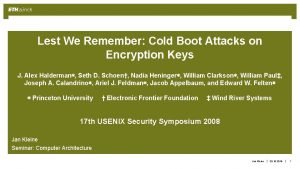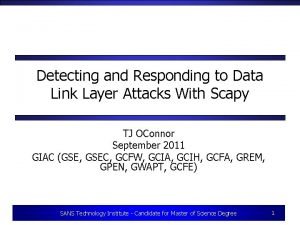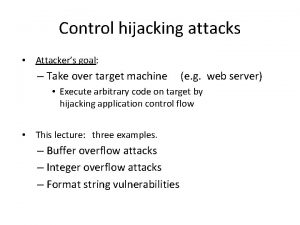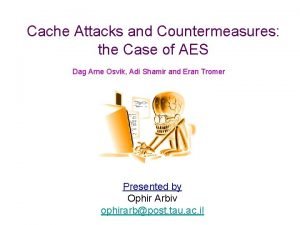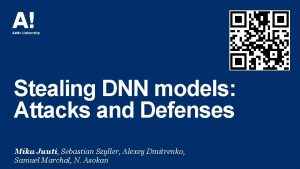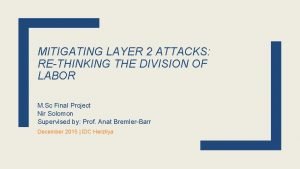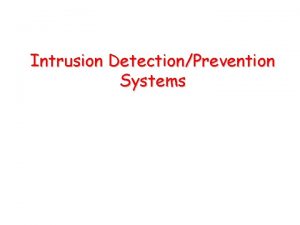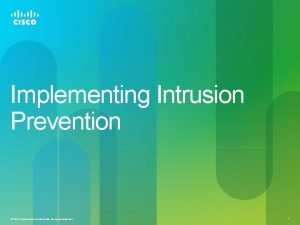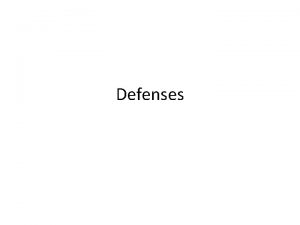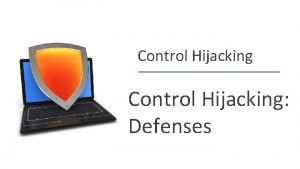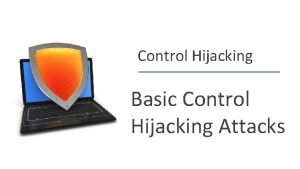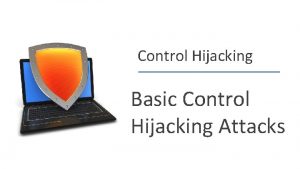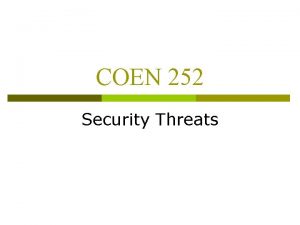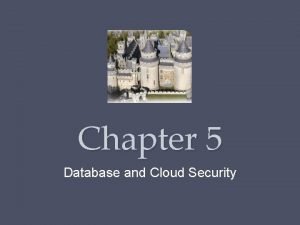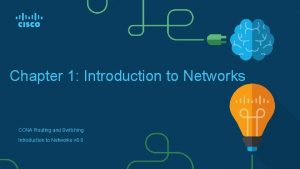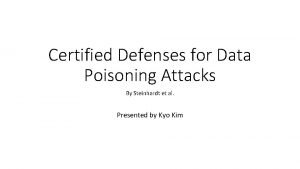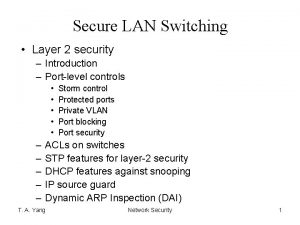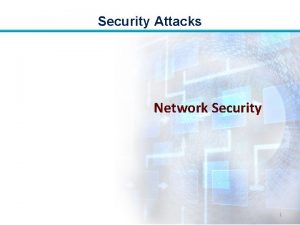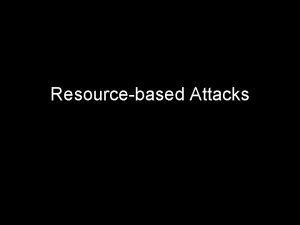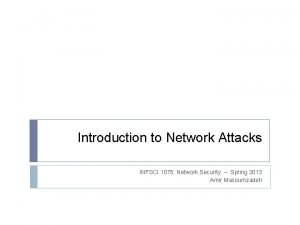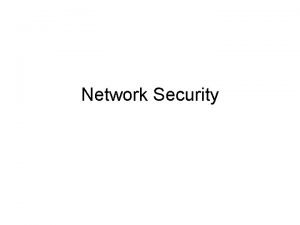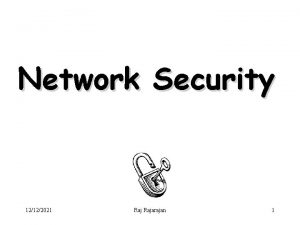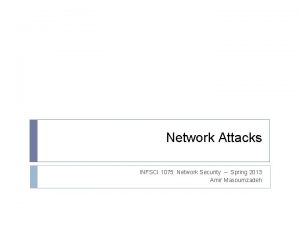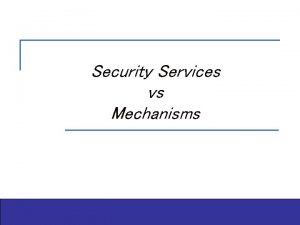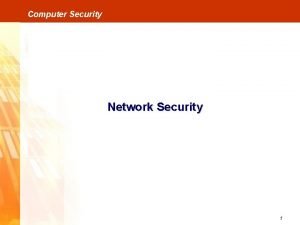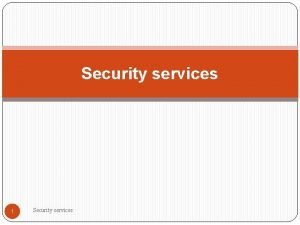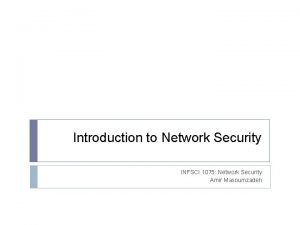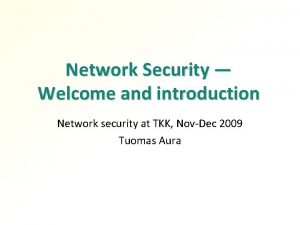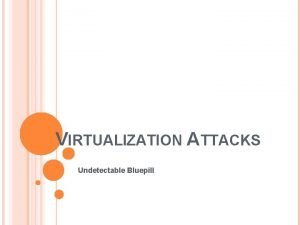Introduction to Network Security 1 Outline Attacks services






































- Slides: 38

Introduction to Network Security 1

Outline • • 해킹 동향 사이버 윤리 Attacks, services and mechanisms Security attacks Security services Methods of Defense A model for Internetwork Security Internet standards and RFCs 2





Virus and Worm • What is Virus? – Self-replicating code – Inserts itself into other executable code – Contains a malicious function, called payload (can be empty) – Native code which infects executable files – Distribution by Email and File sharing – Often requires a trigger from a user • e. g. execute infected application – Virus is often used as a collective term for malware 7

Trojan Horse • A destructive program that masquerades as a benign application. Unlike viruses, Trojan horses do not replicate themselves but they can be just as destructive. – A Trojan horse can be deliberately attached to otherwise useful software by a cracker, or it can be spread by tricking users into believing that it is a useful program. • The term comes from the a Greek story of the Trojan War 8

Virus and Worm • What is Worm? – First Internet worm in 1988 – Different to a virus • • Stand-alone program Does not infect an application Spreads itself through the network automatically Usually spread much faster than viruses – Worms often use exploits to propagate • SQL Slammer – MS SQL Server • Slapper - Apache/Mod-SSL • Code Red – MS Internet Information Server 9






Hacking • 해킹 기법의 변화 • 2000년대 – 분산 서비스 거부 공격(Distribute Denial Of Service) – 분산 반사 서비스 거부 공격(Distributed Reflected Denial Of Service) – 웹 해킹 15






Attacks, Services and Mechanisms • Security Attack: Any action that compromises the security of information. • Security Mechanism: A mechanism that is designed to detect, prevent, or recover from a security attack. • Security Service: A service that enhances the security of data processing systems and information transfers. A security service makes use of one or more security mechanisms. 21

Security Attacks 22

Security Attacks • Interruption: This is an attack on availability • Interception: This is an attack on confidentiality • Modification: This is an attack on integrity • Fabrication: This is an attack on authenticity 23

Security Goals Confidentiality Integrity Availability 24

25

Passive Attacks (threats) - Release of message contents 26

Passive Attacks (threats) - Traffic analysis 27

Active Attacks (threats) - Modification of message contents 28

Active Attacks (threats) - Replay 29

Active Attacks (threats) - Masquerade 30

Active Attacks (threats) - Denial of Service 31

Security Services • Confidentiality (privacy) • Authentication (who created or sent the data) • Integrity (has not been altered) • Non-repudiation (the order is final) • Access control (prevent misuse of resources) • Availability (permanence, non-erasure) – Denial of Service Attacks – Virus that deletes files 32

33

34

Methods of Defense • Encryption • Software Controls (access limitations in a data base, in operating system protect each user from other users) • Hardware Controls (smartcard) • Policies (frequent changes of passwords) • Physical Controls 35

Internet standards and RFCs • The Internet society – Internet Architecture Board (IAB) – Internet Engineering Task Force (IETF) – Internet Engineering Steering Group (IESG) 36

Internet RFC Publication Process 37

Recommended Reading • Pfleeger, C. Security in Computing. Prentice Hall, 1997. • Mel, H. X. Baker, D. Cryptography Decrypted. Addison Wesley, 2001. 38
 Security attacks services and mechanisms
Security attacks services and mechanisms Private secruity
Private secruity Osi security architecture model
Osi security architecture model Security guide to network security fundamentals
Security guide to network security fundamentals Wireless security in cryptography and network security
Wireless security in cryptography and network security Electronic mail security in network security
Electronic mail security in network security Security guide to network security fundamentals
Security guide to network security fundamentals Security guide to network security fundamentals
Security guide to network security fundamentals Network security services nss
Network security services nss Introduction to cryptography and network security
Introduction to cryptography and network security Introduction to cryptography and network security
Introduction to cryptography and network security Introduction to cryptography and network security
Introduction to cryptography and network security How to write a quote sandwich
How to write a quote sandwich Rsa timing attack
Rsa timing attack Attacks on bilingualism represent an ethnocentric
Attacks on bilingualism represent an ethnocentric Lest we remember: cold boot attacks on encryption keys
Lest we remember: cold boot attacks on encryption keys Cross-container attacks
Cross-container attacks Data link layer attacks
Data link layer attacks Buffer overflow in control hijacking
Buffer overflow in control hijacking Malicious attacks threats and vulnerabilities
Malicious attacks threats and vulnerabilities Cache attacks and countermeasures: the case of aes
Cache attacks and countermeasures: the case of aes Sebastian szyller
Sebastian szyller Rendered insecure: gpu side channel attacks are practical
Rendered insecure: gpu side channel attacks are practical Dns spoofing
Dns spoofing Neur ips
Neur ips Layer 2 attacks
Layer 2 attacks Zero-day attacks
Zero-day attacks Zero-day attacks
Zero-day attacks Panic disorder icd 10
Panic disorder icd 10 Hijacking attacks
Hijacking attacks Hijacking attacks
Hijacking attacks Hijacking attacks
Hijacking attacks Hijacking attacks
Hijacking attacks Untargeted cyber attacks
Untargeted cyber attacks A single countermeasure is sufficient for sqli attacks
A single countermeasure is sufficient for sqli attacks Zero-day attacks
Zero-day attacks Certified defenses for data poisoning attacks
Certified defenses for data poisoning attacks Baseband processor
Baseband processor Layer 2 attacks
Layer 2 attacks
